Businesses improve from having tight feedback loops that constantly test the validity of their business equation. The feedback loop and the business equation work to improve each other, which increases your ability to drive impact in the business.
This is because the business equation is your prior on how the world works, and the feedback loops you create help identify the areas where the prior is incorrect. As your business equation improves, the feedback loops will target more and more nuanced things.
The business equation simply takes a set of measurable important inputs and estimates an output. Additionally, while you might not know the values of uncontrollable variables, you should generally know the range that the variables can move in. This is what allows you to do scenario analysis and set your controllable inputs.
However, if the realized output is very different from what is implied by your equation, then at least one critical assumption of your business equation is violated. Most of the time, the reason has to be one of the following three:
There are inputs that you believed were not important, and thus not in your business equation, that actually are.
Some of the controllable or uncontrollable inputs in your business equation are able to move outside of the range you believe they should be within.
Your output is moving in a way that is unexpected given your inputs - something is off with your equation itself.
Your feedback loops should be designed in a way that can help you isolate which of the three reasons is causing your surprise and also gives you a mechanism to iterate on this equation and deepen your learning.
To do this, we need to implement a process that creates a loop of measuring your inputs and outputs, triggering when we see outliers, learning from the outliers, and updating the business equation. See below:
Measure
Keep reading with a 7-day free trial
Subscribe to 100x Manager to keep reading this post and get 7 days of free access to the full post archives.





